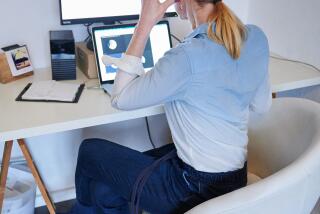Step up activity
- Share via
It’s 3:30 p.m. on a Wednesday, and Dr. Albert Ray has already walked 7,000 steps. He knows this because he never leaves home without his pedometer on his belt. Before bedtime, he will get in 3,000 more steps to meet his daily goal of 10,000 -- about five miles.
While launching a pedometer-based exercise program for Kaiser Permanente employees and members last fall, Ray became a believer in the low-tech electronic step counter.
“I’ve lost about 15 pounds,” said Ray, who coordinates health promotion and preventive care for Kaiser in Southern California. Although his eating habits haven’t changed, his level of activity has risen, he says.
“When I go to the shopping center, I park farther away rather than actively look for a space right near the department store door. I take the stairs.”
For the last few years, national programs such as 10,000 Steps -- which the Kaiser health plan has adopted -- and America on the Move, have encouraged the use of pedometers because the organizers believe the devices can help turn physical activity into a habit. These devices are commonly sold at sporting goods stores for about $10 and up.
Now there’s some evidence from a small study that using a pedometer is a better motivator than simply urging people to get at least 30 minutes of moderate activity most days of the week -- the official government recommendation for good health.
Dixie Lee Thompson, an exercise physiologist at the University of Tennessee, Knoxville, recruited 58 overweight, sedentary women, ages 33 to 55. About half the women were told to take a brisk 30-minute walk on every -- or most -- days of the week. The rest of the women were told to walk 10,000 steps a day and log the steps however they wanted. All the women wore a sealed pedometer that stored the data; the 10,000-step group wore a second pedometer so they could see their daily step total.
“Other studies have demonstrated that pedometers are useful for getting inactive people active,” Thompson said. “What we found is the 10,000 steps-a-day approach led to women walking more than the recommendation to take a 30-minute walk.”
During the four-week study, the walking group overall averaged 8,270 steps a day, while the 10,000-step group averaged 10,159 steps a day.
A daily goal of 10,000 steps has been shown in other studies to be useful in lowering blood pressure and blood glucose levels and controlling weight, Thompson said.
“The 10,000 steps don’t have to be brisk,” she said. And they can be accumulated throughout the day, either through a formal workout, such as a walk, or by routine activities such as taking the stairs instead of the elevator.
What is it about the simple pedometer that helps? “You have a constant reminder of your exercise recommendation, a reminder to build in steps into your day,” Thompson said. Exercise experts know that goal-setting, self-monitoring and reinforcement are all important factors in encouraging regular physical activity. The pedometer provides all three, Thompson said, although she acknowledged that it doesn’t work for everyone.
In the Kaiser program, offered nationwide, more than 16,000 employees and members signed up in the first six months, said spokesman Jim Anderson. “Ninety percent said it helped increase their physical activity; 49% said it helped them lose weight.”
Other workplaces and schools have adopted the 10,000 Steps program or the America on the Move program. Sign up at the Shape Up America website, which hosts the 10,000 Steps program, at www.shapeup.org/10000steps.html, or www.americaonthemove.org.






